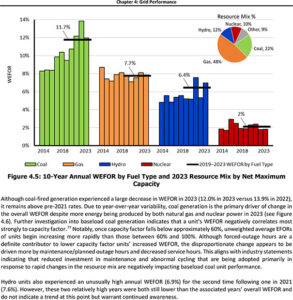Two weeks after visiting Georgia to celebrate the completion of two new reactors at the Vogtle nuclear power plant, Energy Secretary Jennifer Granholm was on stage at the American Nuclear Society (ANS) Conference in Las Vegas, announcing $900 million in federal funding to support the buildout of a pipeline of new, smaller-scale nuclear plants.
The Westinghouse AP1000 reactors now producing power at Vogtle were the first new nuclear plants built in the U.S. since 2016 and came online seven years behind schedule and cost more than double the original estimate of $14 billion. The new federal funding, authorized in the Infrastructure Investment and Jobs Act, is aimed at building market confidence that the U.S. industry will be able to incorporate the lessons learned at Vogtle to deliver a new round of safer, more efficient small modular reactors (SMRs) on time and on budget.
According to a notice of intent (NOI) the Department of Energy issued June 17 ― following Granholm’s announcement in Las Vegas ― the IIJA dollars will be split into two “tiers.” The First Mover Team Support tier will provide up to $800 million for two next-generation light-water SMRs, or GenIII+ SMRs, being developed by teams that include a utility, the reactor manufacturer, a construction company and end users or off-takers.
The teams must have signed contracts in hand and must be committed “to deploying a first plant while at the same time facilitating a multireactor GenIII+ SMR orderbook,” the NOI says.
The Fast Follower Deployment Support tier will split the remaining $100 million between three types of projects that together could help streamline and accelerate project development. The three “sub-tiers” include:
-
- siting initiatives that “lead to multireactor orderbooks of advanced SMRs”
- initiatives to support the buildout of a cost-competitive nuclear supply chain
- initiatives that help GenIII+ SMR projects set and meet their time and cost targets
The NOI also sets out a tentative schedule, beginning with an informational “Industry Day” and meetings with prospective applicants this summer, followed by the opening of the application process. The deadline for applications could be by year’s end, and awards could be announced by summer 2025.
The federal support is intended to “ensure nuclear power ― the nation’s largest source of carbon-free electricity ― continues to serve as a key pillar of our nation’s transition to a safe and secure clean energy future,” Granholm said in a DOE press release. The goal is to “support early movers in the nuclear sector as we seek to scale up nuclear power and reinforce America’s leadership in the nuclear industry.”
But U.S. leadership in nuclear development ― at home and abroad ― has waned as the cost and time overruns of Vogtle have cast a pall over the market, creating a “commercial stalemate,” according to the NOI. “Utilities and end users/off-takers recognize the benefits of and need for nuclear power, but perceived risks of cost and timeline overruns and project abandonment have limited committed orders for new reactors.”
Anticipated growth in power demand could help break that stalemate, said Patrick White, research director of the Nuclear Innovation Alliance.
DOE’s efforts to build an SMR pipeline is “part of a larger conversation about how different energy end users are going to think about trying to meet their clean energy targets,” White said. “I think we’re seeing a lot of conversations about what does it take for a utility to reach net zero? What does it take for things like tech companies that have increasing energy requirements from data centers, from AI computing?” he said.
“There are more and more conversations about how a Generation III+ SMR could help meet those energy needs. So, I think this is another piece of the puzzle of trying to align all the different stakeholders so we can have a reactor technology ready when a project developer, a constructor and an end user are ready to commit to a project and move forward.”
State of the Stalemate
The new Vogtle reactors ― referred to as Units 3 and 4 ― are classified as GenIII+ reactors, which is industry shorthand for the generation of nuclear reactors developed since the mid-1990s, White said. The first generation of reactors was developed in the 1950s and ‘60s, and the second generation ― many of which still are online today ― in the ‘70s and ‘80s.
But the 1,000-MW size of the AP1000 “might limit its application for some utilities … and that total cost of the project might be prohibitive for some smaller utilities,” he said. “And so there was a recognition by advanced reactor developers and by companies that there might be a niche here for using that Generation III+ technology, but on a smaller scale.”
DOE has been funding other advanced SMRs through its Advanced Reactor Demonstration Program (ARDP), which has provided $2.5 billion in IIJA funds to two projects using new technologies. TerraPower’s 345-MW Natrium reactor is designed to be a sodium-cooled fast reactor. The Bill Gates-funded company broke ground on the project June 10 at a site in Wyoming, near a soon-to-retire coal plant owned by PacifiCorp, which is planned to be the primary off-taker for the Natrium plant.
X-energy’s Xe-100 reactors are designed as high-temperature, gas-cooled generators. X-energy is working with Dow Chemical, which plans to install four of the reactors at its Seadrift plant in Texas.
A key difference between the ARDP projects and the GenIII+ SMRs is the fuel they use. GenIII+ SMRs use the same low-enriched uranium (LEU) that powers existing reactors. But both Natrium and the Xe-100 are designed to use high-assay, low-enriched uranium (HALEU), which has a higher concentration of uranium-235, close to 20% versus 3% to 5% for the LEU that fuels most commercial reactors.
Until recently, Russia was the only source of uranium for HALEU, but the war in Ukraine has spurred DOE efforts to develop domestic supplies. A demonstration plant was opened in Ohio in November of 2023, with the goal of eventually producing enough HALEU for both ARDP projects, which are not expected to come online until the end of the decade.
The GenIII+ SMRs now available or in development in the U.S. are mostly sized at 300 MW: for example, the Westinghouse AP300, a smaller version of the AP1000, and GE Hitachi’s BWRX 300. Holtec also is developing a 300-MW GenIII+ SMR, with plans to deploy two of the reactors at its Palisades plant in Michigan, which is in the process of restarting.
The Palisades restart received a conditional commitment for a $1.52 billion loan from DOE’s Loan Programs Office in March. (See LPO Announces $1.52B Loan to Restart Palisades Nuclear Plant.)
But, as DOE notes, the pipeline of committed projects is thin. Billed as the first GenIII+ SMR deployment in North America, the Province of Ontario and Ontario Power Generation (OPG) plan to install four GE Hitachi BWRX 300s at an existing OPG nuclear plant.
The Tennessee Valley Authority also says it wants to install a BWRX 300 at its Clinch River site. CEO Jeff Lyash has spoken about developing a fleet of up to 20 reactors by 2050. (See Making the Case for Nuclear at NARUC.)
Nuclear Capacity Needed
In addition to Vogtle Units 3 and 4, the 93 nuclear reactors in operation across the U.S. provide close to 18% of the nation’s electricity and 45.5% of its carbon-free power, according to the Nuclear Energy Institute, an industry trade group.
In its recent Pathways to Commercial Liftoff: Advanced Nuclear report, DOE estimated that to meet President Joe Biden’s goal of a net-zero economy by 2050, the U.S. will need 550 GW to 770 GW of clean, firm power by 2050. Advanced nuclear could provide 300 GW of that total if the industry can triple its fleet’s 100-GW capacity, the report says.
While some environmental groups, such as the Sierra Club and Greenpeace, remain opposed to the development of any new reactors, nuclear energy has become a rare point of common ground for Democrats and Republicans in Congress. A new bill aimed at streamlining and accelerating nuclear permitting (S. 870) cleared the Senate by a vote of 88-2 on June 18 and is on the way to President Biden. The House passed the bill in May with a strong 393-13 vote.
But will DOE’s $900 million be enough to provide the momentum needed to overcome the legacy of Vogtle and activate the pipeline of orders the NOI envisions?
Again, drawing on the lessons of Vogtle, DOE will prioritize projects that are reliable, licensable and commercially viable, according to the NOI. Teams also must be able to show they’ve agreed on a “preferred reactor technology with a replicable design.”
Catherine Prat, a nuclear engineer and member of ANS, cautioned: “I don’t know if anyone in the design phase of a mega-project would say that any finite amount of money is enough. It certainly helps offset some of the risks, but still requires significant investment from utilities and reactor vendors to develop and deploy the technology.
“It is a significant step for DOE to recognize that some level of government support is necessary, and I think it’s fair to say the industry is appreciative of that,” Prat said in an email. “Let’s not let perfection (enough money) be the enemy of good (some money [and] movement in the right direction).”
Getting a pipeline of projects over the post-Vogtle hump will require “really trying to align the business models and business requirements for all the different commercial players that are going to need to work together,” White said.
DOE “is trying to help kind of create a framework or a way to have incentives for these different companies to come together and say, ‘What is a business model that makes sense for these first movers and for fast followers?’ Does providing this additional funding help them to retire risk related to design, related to siting, related to licensing, related to supply chain, or is it a way to just help maybe reach alignment faster?
“How do you get to five reactors? How do you get to 10 reactors that really help lower the cost of all the technologies overall?”

